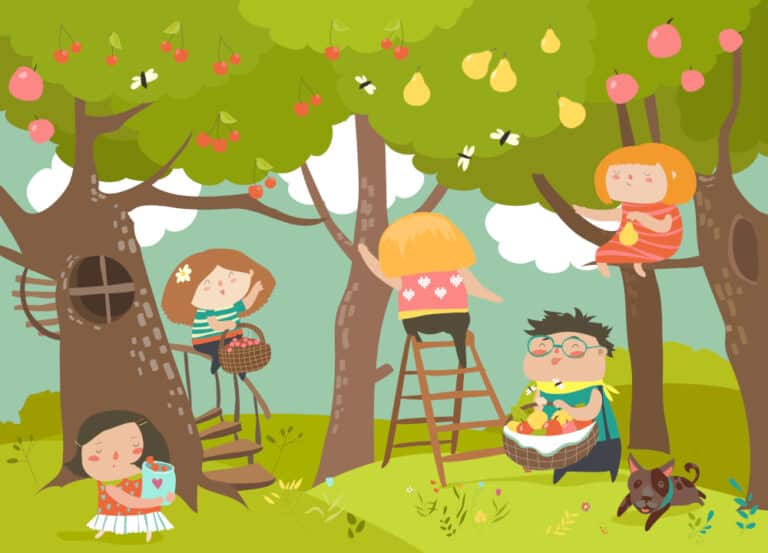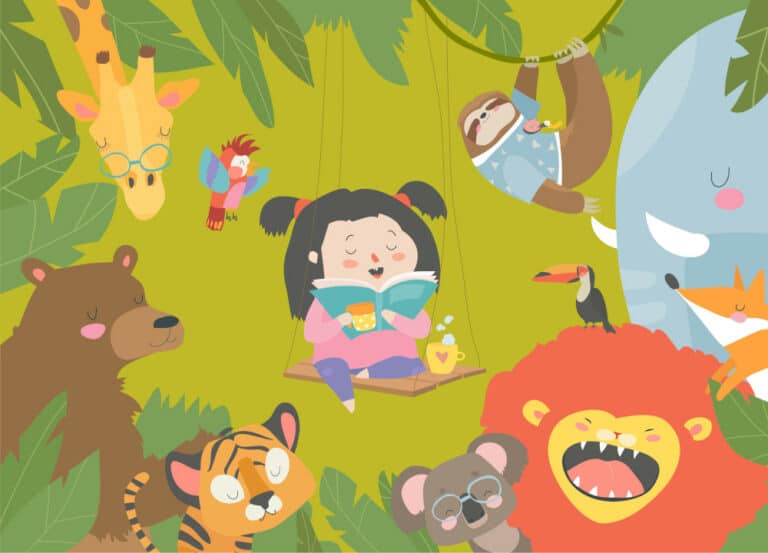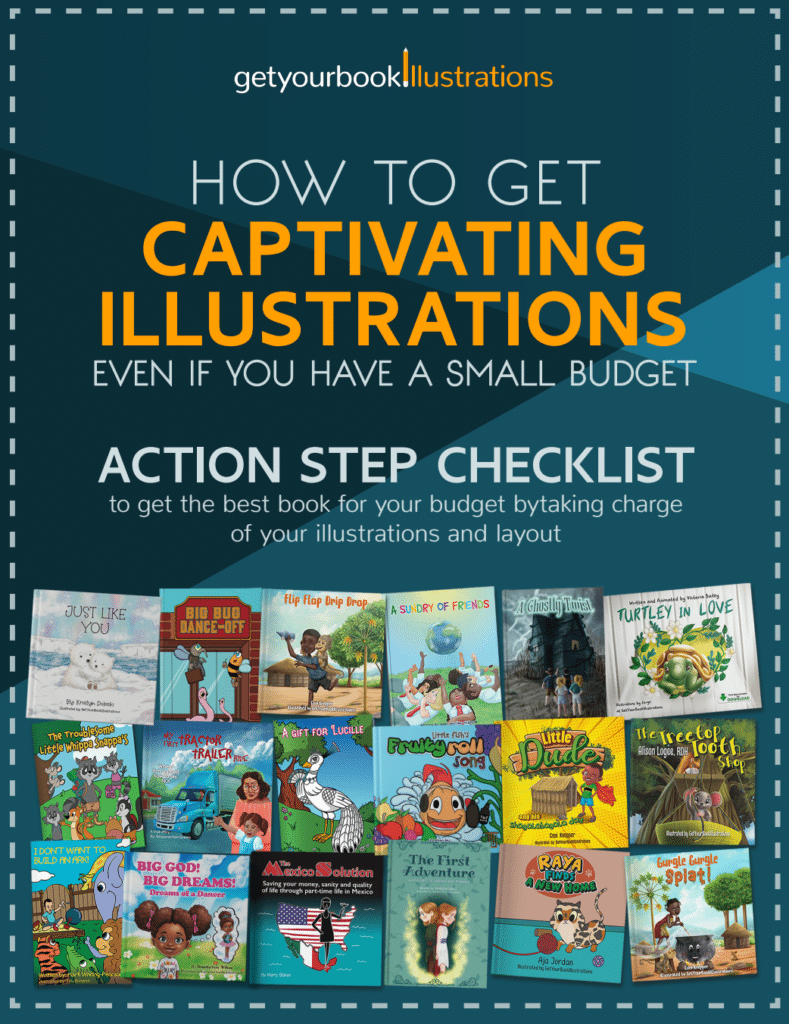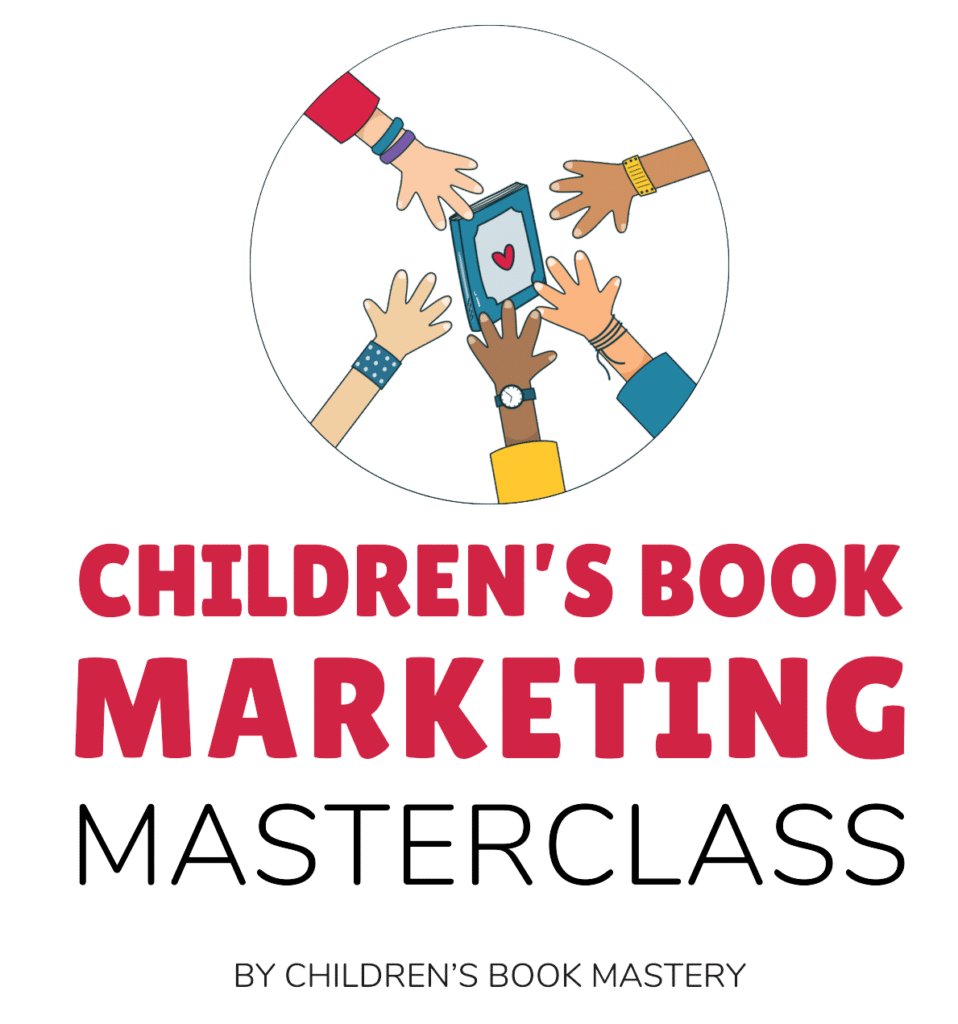How To Write a Children’s Book (With Template PDF)
It can be daunting to figure out how to write a children’s book, but it doesn’t have to be! If you know how to come up with ideas for writing a children’s book, the right structure to use, how to develop characters, and other steps, you can craft a captivating story that children will love.
To help you out, this blog article provides you with a comprehensive guide and a free children’s book template PDF to help you create your own children’s book.
Reasons To Use The How to Write a Children’s Book Template
Using the How to write a children’s book template PDF will help you come up with ideas for writing a children’s book and provide you with the structure and guidelines to help you write your story.
This template helps you start off on the right foot and makes it easier to craft a story that is engaging and flows well. It also allows you to plan and organize your story better, as it provides you with the principles of how to write a children’s book that is memorable and that children will enjoy.
But don’t skip this article! It will help you get the most out of the template!
You can download the How to write a children’s book template PDF here.
Your Idea
In brainstorming ideas for writing a children’s book, it’s important to consider the kind of story you want to tell. You might focus on a particular theme, such as adventure, friendship or courage, or explore a certain moral or lesson. Regardless of the theme or moral, your primary focus must be on making your story engaging for the young reader.
When writing a children’s book, the reader’s enjoyment is the first priority. This means focusing on the main characters and an exciting or entertaining plot. Even if your story has a moral or message, the moral or message should be secondary. If it is subtle and entertaining, it will be more likely to be remembered.
A great way to come up with or improve ideas, is to ask, “What if?”
Take an existing idea or any ordinary scenario, and ask “what if…”.
“What if your character had a superpower? What if the story happened under the ocean? What if it happened in the future? How would that look? What if the character didn’t follow the rules? And then what would they do next?”
You can also re-imagine a famous story.
Once you have a basic idea of what you want your story to be about, it’s time to craft your story.
The Structure of a Children’s Book
When writing a children’s book, structure is key. Think about the story arc and how it will unfold from beginning to end. Keeping structure in mind from early on will help you organize your ideas and make sure that the story flows well and is easy to follow. Without this, the story could become confusing.
Your plot should have a clear beginning, middle, and end. For example, your story might start in a creepy house, the middle could move outside to the garden, and the end could be at bath time in the evening.
A typical children’s book plot looks like this:
The set-up can be very short and is where you introduce the main character(s) and set the scene for the story.
The inciting incident is where your character decides they want to achieve something, or something happens to them, which sets the story into motion. This is where the action starts.
From here, the action builds as the character attempts to reach their goal.
The climax is the point of highest tension. This is the do-or-die moment where your character fails or succeeds.
After this, there is diminishing action where you tie up any loose ends, or we may see how the adventure changed your character.
Last, we have a satisfying resolution. Children’s books should always have a satisfying ending that wraps the story up. No cliffhangers!
Once you have the plot down, think about the pacing of the story. You want to keep your reader engaged and make sure the story doesn’t become too slow or too fast. Use techniques like cliffhangers to help keep the reader’s interest and make sure the story doesn’t become predictable.
Finally, consider the structure of each scene or chapter of the book. In children’s picture books, each spread (an open book where we see two pages is called a “spread”) is a scene. In longer books, scenes are longer, but chapters must not be too long, so as not to overwhelm the reader. Regardless of which type of book you are writing, each scene should have a clear purpose and move the story forward.
It is important to think about the child’s age when crafting your story. Make sure the language and concepts you use are appropriate for the age range of your intended audience. Similarly, the pacing of your story should be suitable for the young reader.
If you’re feeling stuck, use the free children’s book template pdf to help you with your structure. It can help you organize your thoughts and ensure you don’t forget any important elements of the story.
The Character
A well-structured, believable and memorable main character is essential, so that your readers can easily connect with them. Without a relatable main character, readers won’t connect with your story, since they experience the story through the main character.
This is so important that many successful series are built solidly on the main character’s likeability.
Think about their personality, motivations, and goals. What obstacles do they face, and how do they overcome them?
Ideas For Character Development
When developing your characters, think about their age, likes and dislikes, strengths and weaknesses, and any other characteristics that will make them stand out. How do they interact with other characters and how are they affected by the events that occur?
Learn more about character development in the Develop your characters section of this article.
You can also use this Quick Character Generator to help!
The Goal or Overall Problem They Face
When writing a children’s book, one of the most important things to consider is the overall problem that your protagonist faces. Your main character should be deeply invested in this problem, as it will drive the story forward and keep the readers engaged. For a story to be truly engaging, it needs a conflict at the heart of it.
The conflict must be personal to the protagonist and a problem that they must solve. This makes your story, as the main character goes on a journey and runs into obstacles they must overcome in order to solve this overall problem. The problem instigates the character’s grand adventure.
A great way to create a sense of adventure in your story is to make sure that the protagonist’s journey is full of unexpected turns and thrilling moments. Give them a goal or problem and then put them in a situation where they must use their courage, intelligence and wit to get out of it.
It’s also important to make sure that the stakes are high and that you keep the reader on their toes as they follow the protagonist’s journey.
As you write your story, remember that conflict is essential to any great adventure. It brings the story to life and provides the reader with an exciting journey to take with the protagonist. So make sure that the main character faces a problem that they must overcome. By doing this, you will create an engaging and thrilling children’s book.
The Obstacles They Face
In facing the key problem, or attempting to reach their goal, the main character will run into challenges. Think about the obstacles your character(s) will face throughout the story and how they overcome them.
These obstacles cause the conflict and tension that are so crucial to making a good story. This is where we get the building action of your story.
Usually, for children’s picture books, the character will face three obstacles. So they’ll fail when they face the first obstacles, and then only succeed (or fail) when they face the final, biggest obstacle at the climax of your book.
Facing these obstacles can cause internal or external conflict. The internal conflict is the struggle that the character faces within themselves and is often the greatest conflict of all, while the external conflict is the struggle that they face against outside forces.
Revision
Once you’ve written your story, you need to revise.
Neil Gaiman gives wonderful advice about this: “The best advice I can give on this is, once it’s done, to put it away until you can read it with new eyes. Finish the short story, print it out, then put it in a drawer and write other things. When you’re ready, pick it up and read it, as if you’ve never read it before. If there are things you aren’t satisfied with as a reader, go in and fix them as a writer: that’s revision.”
The difference between an okay book and a great one is revision, revision, revision. Professional authors revise their work many times, and if you want to publish wonderful work, so should you.
If you want to be guided through the many steps of revision in detail, have a look at the Unlock Your Picture Book Course.
Book dummy
If you are writing a children’s picture book, once you are happy with your story, create a book dummy! This is an extremely helpful tool for a picture book author, because unlike a novel or other books, what text goes on what spread is very intentional.
First, create your book dummy.

Then, write your text throughout the book dummy, as you envision it will be in your book. It doesn’t matter where on each page you write it, only that you divide it up spread by spread as you think will work well.
Then, use your book dummy to check:
- Pacing: Does the story move forward on each spread?
- Pacing: Are there sections where the story is moving forward too slowly?
- Pacing: Does the story start fast enough? (It should start by the third spread.)
- Pacing: Does the story end fast enough? (After the tension is resolved, there should only be one or two spreads to wrap everything up.)
- Page turns: Does every spread make you want to turn the page?
- Text: Are there any pages with too much text?
- Illustrations: Are there any spreads where you’d like to remove all text and only have illustrations?
Mockups
This is an optional step, but you can create a mood board and get an idea of what your characters and book illustrations will look like. This article can help you decide which types of illustrations you would like for your children’s book.
You can also think about the font, word placement, and any other details that will make your story stand out.
You can also leave these steps to your illustrator and book designer.
The Next Steps
If you want to go through an agent or traditional publisher, the next step is to find one. In this case, don’t do the steps below, as your publisher will take care of these for you. Be aware that it can take a long time to find a publisher, and then it will take at least one year before they publish your book. Also, read up about royalty share and the other details about working with a publisher.
If you will self-publish, the steps below are your next steps once your manuscript is done.
Marketing
Marketing is a big subject that we won’t cover in this article (but we’ll keep adding articles to this blog about marketing, so keep an eye out!). The only advice I’ll give here is that you can never start too early. Don’t wait until you publish to start because then it is really hard to build momentum. Start today!
Editing
Hire a professional editor to review the book. A professional editor will help ensure that the book is well-written by pointing out and guiding you on any issues with the plot, character development, writing craft, etc. This is crucial, so your book becomes the best it can be.
Also get proofreading to clean up any spelling and grammatical errors.
Illustrations
Illustrations are a key part of any children’s book, especially for younger kids, and bring the story to life. Choose an illustrator that not only has beautiful art, but has experience in illustrating children’s books and who communicates and understands you well.
For illustrations, it’s best to follow a four-step process you can find here. This will give you the most professional outcome. You can also learn more about how illustrations are completed and how to work with an illustrator here.
Book Design
Once the illustrations are complete, the book design process will begin, where the book interior and cover are laid out and designed. Your book designer will also select the typefaces, colours, and overall look and feel of the book.
Publishing
After the book is ready to go, it is time to publish! Most self-publishing authors publish on KDP and IngramSpark, but you can research other options, like Draft2Digital, Lulu and Blurb.
Publishing is a process on its own. Learn more about it in our other blog posts, in this How to Publish a Picture Book article and I Want To Write A Children’s Book. Where Do I Start? Article.
For more comprehensive, step-by-step guidance, have a look at the Self-Publish Like a Pro Course here.
___________
By following the above steps, you, the aspiring children’s book author, can ensure that your book is properly edited, illustrated and designed, and will be ready for a successful publishing journey.
Closing
With the knowledge in this article and using the free How to write a children’s book template PDF, you’re on your way to becoming a successful children’s book author! With the right ideas, structure, characters and illustrations, you can create a captivating children’s book with a story that flows and will be a hit among your readers.
If you’re looking for more information on how to write a children’s picture book, invest in the Unlock Your Picture Book course. This course is designed to help aspiring authors like you (and even published authors) learn the ins and outs of writing and revising a children’s picture book, to make it the best it can be. With the step-by-step guidance in the course, you can have your book published and ready for readers in no time!







Excellent ideas! Thank you so much .
These are wonderful reminders and guides to use in creating ANY story….especially children’s books. Thank you so much!
Great template with great further resources! I particularly like the book dummy idea that I find practical. Thank you, Karen!
Thank you for sharing! I am ready to publish and would appreciate information about the best way to publish without investing lots of money.
Thanks for the feedback, Wendy. I will look into doing an article like that! To get the best book possible, you have to be willing to invest some, but I can advise on ways to save money on some of the steps.
Hi! I wish to say that this post is amazing, nice written and include approximately all vital info. I’d like more posts like this.
Excellent blog here! Also your site loads up fast!
I’m truly enjoying thhe design and layout of your site. It’s a very easy onn the eyes which makes it much more enjoyable for me to come here and
visit more often. Did you hire out a designer to create your theme?
Fantastic work!
Thanks! I designed this site. I’m glad you are enjoying it!
It’s a remarkable article for all the online viewers; they will get advantage from it I am sure.
This website was… how do you say it? Relevant!!
Finally I’ve found something which helped me.
Kudos!
I’m really enjoying the design and layout of your website.
It’s a very easy on the eyes which makes it much more enjoyable for me to
come here and visit more often. Superb work!
Hey! I realize this is somewhat off-topic however I needed to ask.
Does running a well-established blog like yours take a massive amount work?
I’m brand new to blogging but I do write in my journal on a daily basis.
I’d like to start a blog so I will be able to share my own experience and views online.
Please let me know if you have any kind of recommendations
or tips for brand new aspiring blog owners. Appreciate it!
Hi Hans. The amount of work really depends on you and how much time you put into each article. Posting them online is fairly simple. It’s good for authors to have blogs, so go for it. I would recommend learning about SEO, so you can attract visitors with your articles!
I have been exploring for a little for any high-quality articles or blog posts about this. Exploring in Yahoo, I at last stumbled upon this site. Reading this information, I’m satisfied to convey that I have a feeling I discovered exactly what I needed. I will remember this website and give it a glance on a constant basis.
This is a topic that is near to my heart… Best wishes! Exactly where are your contact details though?
Hi Sonya, you can contact us on [email protected].
I need to to thank you for this excellent read!! I certainly loved every little bit of it. I have you bookmarked to check out new things you post…
Attractive content. I simply stumbled upon your website and in fact enjoyed your blog posts. Anyway I’ll be subscribing for your feeds.
With having so much content, do you ever run into any issues of plagiarism or copyright violation? My website has a lot of unique content I’ve either created myself or outsourced but it seems a lot of it is popping it up all over the internet without my permission. Do you know any solutions to help protect against content from being stolen? I’d genuinely appreciate it.
Hi Landon. Yes, we’ve had some content plagiarized. Google can tell which one is the oldest and will never show the newer (plagiarized) ones in a Google search. Other than that, I haven’t found any solutions.
My brother recommended I might like this website. He was totally right. This post actually made my day. You can’t imagine just how much time I had spent for this information! Thanks!
Terrific post however I was wanting to know if you could write a little more on this subject? I’d be very thankful if you could elaborate a little bit further. Appreciate it!
I found exactly what I was looking for. You’ve ended my four day long hunt! God Bless you man. Have a nice day. Bye
Hi, I do believe this is a great site. I stumbled upon it 😉 I saved as a favorite. May you continue to guide others.
Great weblog here! Additionally, your site loads up very fast! What web host are you using? Can I get a link to your host? I desire for my site to load up as fast as yours lol
I usually do not leave a great deal of remarks, however after browsing through a lot of comments here on How To Write a Children’s Book (With Template PDF), I actually do have a few questions for you if you tend not to mind. Is it just me or do a few of these comments appear like they are coming from brain dead people? 😛 And, if you are writing at other sites, I would like to follow anything fresh you have to post. Would you post a list of the complete urls of your social sites like your Facebook page, twitter feed, or linkedin profile?
Hey there! Do you know if they make any plugins to assist with Search Engine Optimization? I’m trying to get my blog to rank for some targeted keywords but I’m not seeing very good success. If you know of any, please share. Kudos!
Aw, this was an incredibly good post. Spending some time and actual effort to create a superb article but what can I say, I procrastinate a whole lot and never manage to get nearly anything done.
I think this is one of the so much significant info for me. And i’m glad studying your article. The website style is perfect, the articles are actually nice : D. Excellent activity, cheers!
I do not even know how I ended up here, but I thought this post was great. I don’t know who you are but certainly you’re going to a famous blogger if you aren’t already 😉 Cheers!
Have you ever considered writing an ebook or guest authoring on other websites? I have a blog centered on the same ideas you discuss and would really like to have you share some stories/information. I know my visitors would appreciate your work. If you are even remotely interested, feel free to send me an email.
Everything is very open with a very clear explanation of the challenges. It was really informative. Your site is very useful. Many thanks for sharing!
I am really impressed with your writing skills and also with the layout on your blog.
Is this a paid theme or did you customize it yourself? Either way keep up the excellent quality writing, it’s rare to see a great blog like this one these days.
Thanks! This site is made with Kadence, and I’m glad you’re enjoying the blog posts!
Everything is very open with a clear clarification of the issues. It was really informative. Your site is extremely helpful. Many thanks for sharing!
Hi, its a nice post about media print, we all be aware of media as a great source of data.
Thanks for talking about > How To Write a Children's Book (With Template PDF).
I every time spent my half an hour to read this website’s posts all the time along with a mug of coffee.
I was able to find good info from your blog posts.